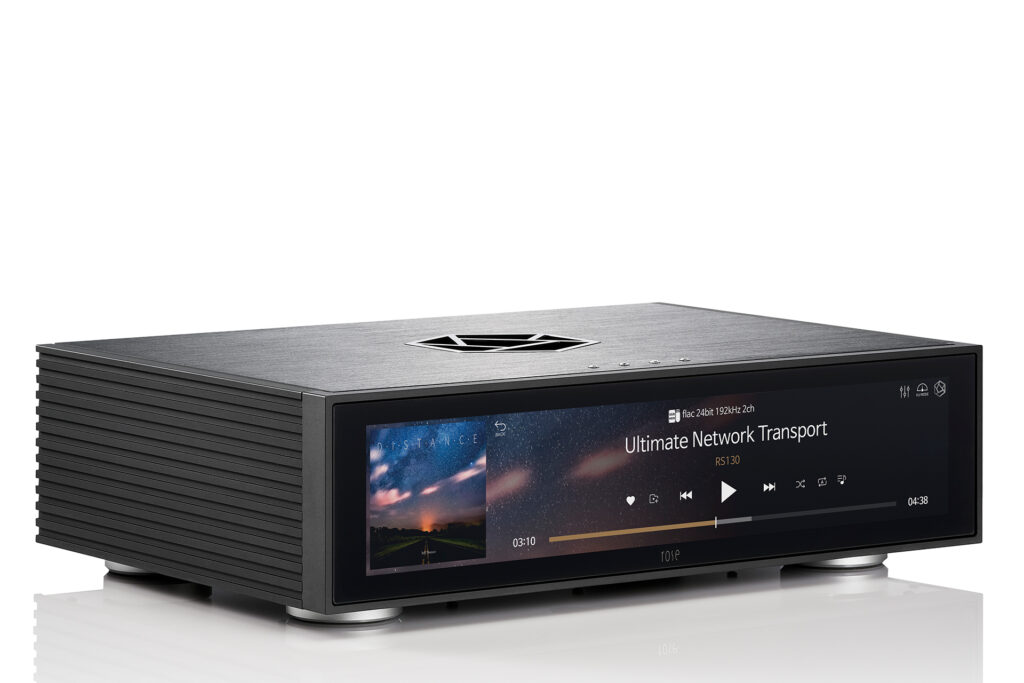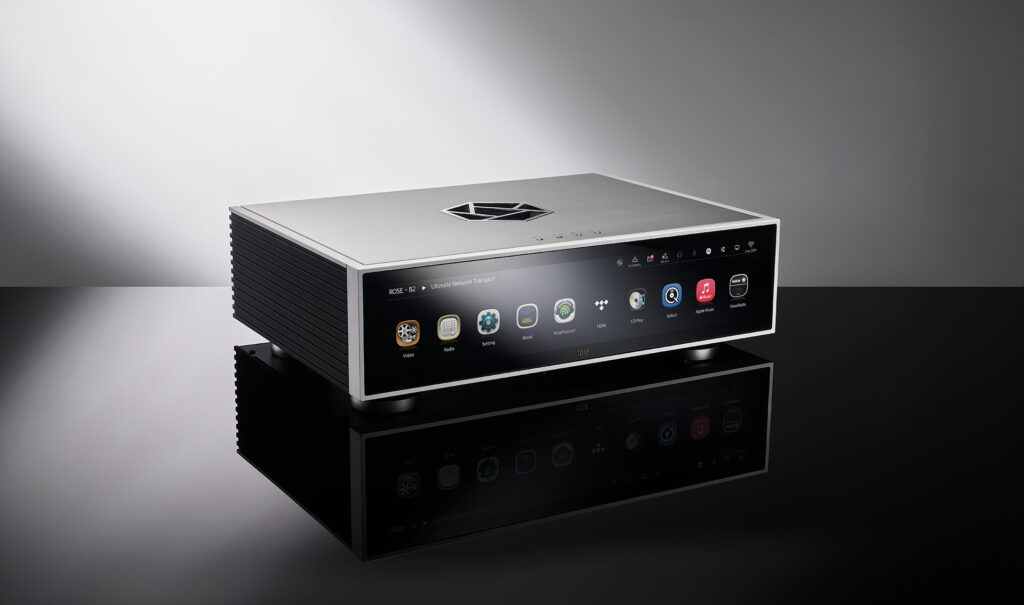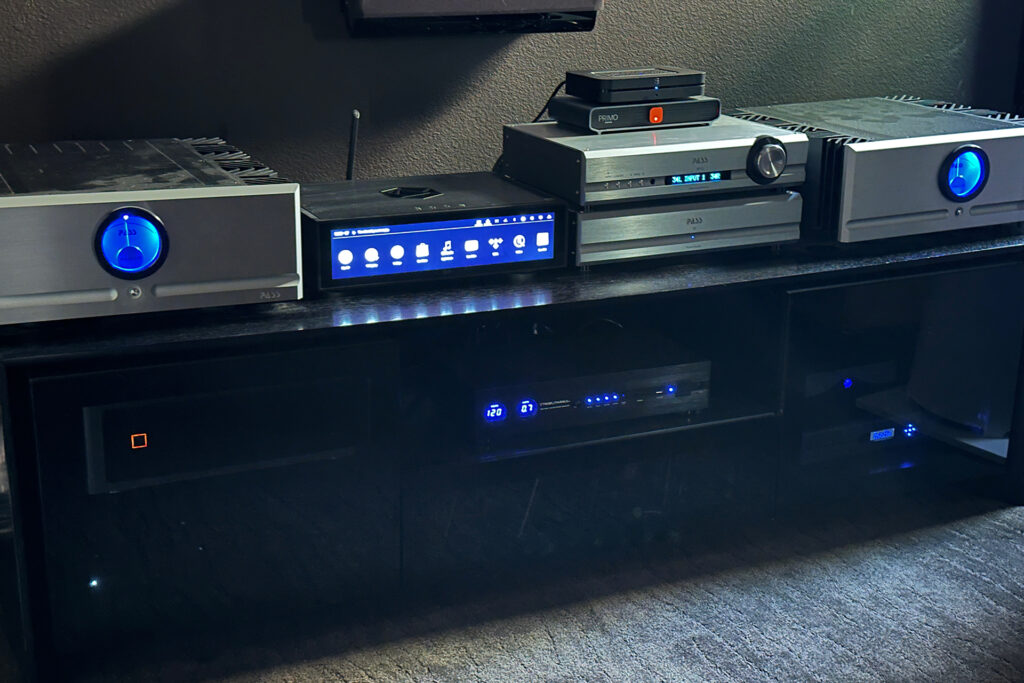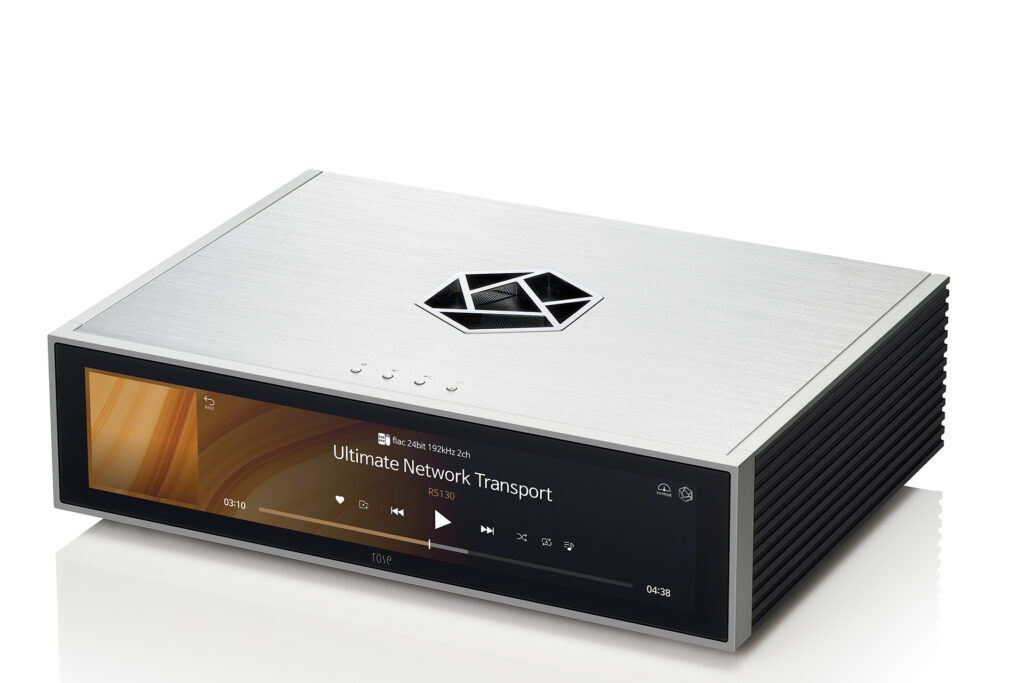HiFi Rose, a newer company in the high-end audio community but with 50 years of experience in touchscreen interfaces, has quickly become a leader in digital music players, and Class-D GaN FET amplifier design. HiFi Rose uses the term “network transport” when referring to their new flagship RS130, which I would typically refer to as a “streamer,” which retails for $5,195.However, HiFi Rose uses the term “streamer” for a component that combines a network transport and DAC (digital-to-analog converter). We will keep that in mind during this review. The RS130, or any other network transport, uses a dedicated computer to retrieve and process music files from subscription music streaming services, or digital music files stored on a local area network attached storage (NAS) drive or USB drive, and outputs the digital signal to an external DAC. Creating a component for a single function is not a new concept; similar to other separate audio components in an audio system, separating the noisy computer aspect of digital music from sensitive DAC electronics makes sense.

We know DACs can impact digital music, but I am concerned as to whether a $5,200 network transport can make an impression justifying its expense. With so many new competitively-priced entrants within this product category, and stellar improvements at each new rollout, the justification of pricey network transports, streamers, or streaming DACs becomes quite tricky. But then the Hifi Rose RS130 (buy at Crutchfield) was at my door. In today’s review, we will dive deeply into the HiFi Rose RS130, their first dedicated ultra-sophisticated network transport to date, and see if we can justify its existence.
What Makes the HiFi Rose RS130 Network Transport So Special?
- The HiFi Rose RS130’s design goal was to deliver pristine sound by eliminating digital noise and maintaining stable output. While many network transport manufacturers claim the same, the HiFi Rose RS130 attempts to go further in achieving its lofty design goal.
- The substantial solid aluminum casework dissipates vibration, isolates the power supply from outputs, and includes a clever ventilation outlet, shaped like the HiFi Rose logo, and four crystal control buttons on the top panel. The fit and finish of the RS130 is stunning.
- The HiFi Rose RS130 uses fiber optics on Ethernet input and the USB 3.0 fiber output to control the noise that enters and exits the network player respectfully.
- A complete set of digital outputs, including I2S, USB, AES/EBU, RCA, TosLink Optical, and HDMI, allows you to find the path you like best, and for connectivity to legacy or future DACs you may own. Also, note that these outputs can have higher bit rates and sampling frequency output than ordinary network transports.
- The HiFi Rose allows selectable control to up-sample native PCM frequency and DSD mode: DSD native, DSD over PCM, or DSD to PCM.
- The HDMI output sends digital audio and video, i.e., cover art and track information, to a surround sound receiver or processor and display.
- The Hifi Rose RS130 uses a linear power stage with an uninterruptible power supply (UPS) supercapacitor design that acts like a low-noise battery power supply.
- Rather than buffering or using a hard disc drive, the RS130 uses a 256-megabyte SSD (solid state drive) for music caching that provides stable playback.
- High-precision OCXO (oven-controlled crystal oscillator) maintains perfect temperature for precision clock performance, with extremely low jitter.
- A master clock input allows connectivity to an external clock to synchronize both streamer and DAC.
- The HiFi Rose includes software to control volume if you would like to bypass the need for a preamplifier.
- The HIFI Rose RS130 is a full-size audio component with a 15.4 TFT LCD Capacitance touchscreen that covers the entire component front facia for fast-reacting control and an impressive appearance. The relevance of a screen can be questionable on most network transports. However, with the RS130’s many digital outputs, processing choices, and setup configurations, the relevance of the large touchscreen becomes apparent. For fun, the display can convert into dual VU meters with various color choices when desired.
- The HiFi Rose RS130 integrates with Spotify Connect, which allows Spotify’s native APP control.
- The Rose Connect control app integrates Tidal, Qobuz, Apple Music, Bugs, Rose Tube, and Internet Radio. Apple Music integration is rare amongst transports, due to the hurdles imposed by Apple and the requirements for applying the software development kit (SDK) to a system. Additionally, the SDK does not support lossless audio, but HiFi Rose is hopeful that it will. However, the Apple Music integration bypasses Airplay, which would otherwise be required.
- The HiFi Rose RS130 supports Airplay, DLNA, and is Roon-ready.
- Users can install an internal SSD drive of up to four terabytes to store music files. A USB flash drive or a NAS drive can also be connected.
- The HiFi Rose comes standard with a good-quality remote that controls basic operations. I used the Rose Connect app or Roon to control the RS130, but the remote is there if you need it.
Why Should You Care About the HiFi Rose RS130 Network Transport?
The HiFi Rose RS130 takes streaming to a new performance level and form factor. With every conceivable digital output available today, vast processing control features, supercapacitor power supply, flawless construction and, of course, the touchscreen interface, the RS130 is easy to love. Sure, there are less expensive alternatives, but they won’t have the functionality and performance that the HiFi Rose RS130 offers. Do you need such exorbitant performance, control, and features? It depends on whether your audio system is revealing and how performance-conscious you are.Either way, it is nice to know that the RS130 is there for the taking, if we have the means. And if we don’t, we know what to look for in competitors’ products, since we now know what is possible. We should care about the HiFi Rose RS130, because it sets a new bar for the industry, making competitors wake up and attempt to keep up. When they do, prices will fall, which is good for everyone.

Some Things You Might Not Like About the HiFi Rose RS130 Network Transport …
- One reason I love the RS130 could be an issue that some may dislike: the RS130 is a massively well-built, full-width audiophile component. At 17 inches wide, 12.5 inches deep, and five inches tall, it is a centerpiece component at 26.5 pounds that will wow friends and family. But, if you are tight on space, this unit may not work for you.
- Like most audiophile network transports today, the RS130 has limited music service integrations. However, Bluesound, with its BluOS, has spoiled many with over 21 streaming services integrated into their operating system and app. Although most audiophiles have learned to be all-in with Tidal or Qobuz, due to their high-resolution streams, why should we be so limited? Many music lovers like Pandora, and some Amazon Prime members enjoy the experience and pricing they receive with Amazon Music Unlimited. However, there could be hope, since music streaming services will be added to the HiFi Rose OS, depending on market demand and whether the service offers high-resolution streaming. HiFi Rose advised that an Amazon Music integration is in the making for the RS130.
- While Tidal is integrated into the Rose Connect APP and Roon, Tidal Connect is not supported. If there was demand, I could see HiFi Rose adding the Tidal Connect feature, but I doubt it is needed.
Listening to the HiFi Rose Network Transport …
My current reference system is a Pass Labs XP 22 preamplifier, wired to a pair of Pass Labs XA60.8 high-current monoblock amplifiers, operating in full Class-A mode up to 60 watts at eight ohms, doubling power at four ohms, and again at two ohms.
The HiFi Rose RS130 will connect to a PS Audio Stellar Gold DAC, using mainly the I2S connections. Estelon Aura floorstanding speakers would be the final stage of my system, creating a highly-resolving platform. The system benefits from Wireworld Eclipse 8 speaker cables, interconnects, and Electra 7 power cables for the amplifiers.
The first song is “Lonely Road” by Jelly Roll and M.G.K, from the recent album Unbroken. Through the Rose HiFi App, Tidal 24/48kHz FLAC, it was easy to notice a level of enhanced clarity and detail, but at the same time, a smoothness, especially on vocals. I was surprised at the magnitude I could audibly hear so vividly. I thought that the network transport portion of streaming would make less difference. Recently, I reviewed the PS Audio AirLens, where I experienced an audio improvement. It was more incremental but improved. Now, in a side-by-side comparison, the HiFi Rose improvement is more encompassing, touching on every area. It is a noticeable difference, best described as an improvement in various areas, more significant than the sum of its parts. Instruments took on a spatial distinction within the soundstage, while vocals were smoother with more detail where both artists’ subtleties, like breathing, could be heard. The AirLens is very good, but the RS130 has an edge and, at more than twice the price, it should.
With this same track, and the HiFi Rose app, now using Qobuz, 24/48kHz, there was even more bass and coherence across the frequency range.
Moving on with Roon, with this same track, it was hard to discern differences between Tidal and Qobuz streams. However, Roon typically sounds better with a more profound, detailed bass response and overall realism, which was apparent here.
I switched up to a track that stands the test of time, Fleetwood Mac’s “Gypsy” from their 1982 Mirage album, through Roon streaming from Tidal 24bit/192k FLAC. Again, experiencing enhanced smoothness and clarity added realism. At two minutes and thirty seconds into the track, on the right side of the soundstage, a light tambourine is easily unnoticed if the system is not up to the task. Here, its presence was still faint, but harder to miss than with the PS Audio AirLens.
Mumford and Sons’ “Little Lion Man” from their 2009 Sigh No More album is a vocal-heavy track that I streamed through Roon from Qobuz FLAC 48kHz 24bit. The vocals are clear yet relaxed, with more improved realism than I have ever heard before in my system. The acoustic guitars are incredibly articulate. The imaging and soundstage were excellent, defined, and encompassing.
I switched from I2S output on this track and experimented with USB and Coax digital. All were excellent, and it was hard to parse differences, but if I had to call it, I would give it to the I2S path. At this level of sophistication, all outputs use the highest-quality electronics, making them sound excellent.
Will the HiFi Rose RS130 Network Transport Keep its Value?
The resale value of the RS130 won’t matter, because once you have experienced it, you won’t sell it. However, if the need arose, given that it is a digital component, it would be subject to innovations from competitors. We all know computers become faster and more capable with lower prices over time. Alternatively, the RS130 is a highly specialized computer; its speed is optimal now and will work just as well in the future. Also, updates will keep this unit more relevant over time. It will hold its value better than average.

What is the Competition for the HiFi Rose RS130 Network Player?
I kept the competition selection to dedicated network transports to compare apples to apples – like the HiFi Rose RS130, these components do not have DACs.
Would you believe Aurender has five network transports, ranging from $3,500 to $25,000, in its lineup? The N200 network transport is second from the bottom. I mention it only because it is close in price to the HiFi Rose, retailing for $6,300. It is similar to the RS130’s sophistication, but is short on features and overall comparative quality. The third model from the bottom of the Aurender lineup is more similar, the N20SE. At $12,500, it is cut from the same cloth as the HiFi Rose RS130, due to the implementation of a unique power supply, noise isolation techniques, cache playback, OCXO clocks on various outputs, SPDIF outputs capable of higher bit rates and processing speeds, and the ability to up-sample music files if desired. While the N20SE beats the RS130 in internal SSD storage capability, it is short on output choices like I2S and HDMI. The outputs the N20SE offers are highly sophisticated, like the HiFi Rose. Both brands sport skilled fit and finish, but the RS130 goes further with the finesse of a touchscreen interface and is $7,500 less. I have yet to experience the Aurender N20SE, so I cannot speak on its performance, but this option shows that alternative hot-rodded transports are available.
The Aries G2.2, which costs $6,099, is Auralic’s version of a no-compromise network transport, like the RS130 and Aurender’s N20SE, with similar efforts in substantial casework, power supply, cache memory playback, galvanic isolation on a variety of outputs, and up-sample control. However, like the Aurender, the I2S and HDMI outputs are nonexistent in the G2.2. The transport interface on the G2.2 is not on par with the HiFi Rose RS130’s sophistication. Interestingly, Auralic offers its products online and through dealers, where the G2.2 is currently on sale. The reduced pricing may be due to the disruptive competitive forces brought on by the HiFi Rose RS130. Admittedly, I have not experienced the Auralic G2.2, so I cannot comment on its performance, but it is another choice of extreme transport design.
The Lumin U2 Network Transport is another upper-class network transport retailing for $5,000. The U2 has significant noise-isolating casework, exotic power supply, cache memory playback, a variety of high-resolution digital outputs, up-sample control, and their proprietary Leed volume control. However, it lacks the I2S and HDMI digital outputs. The small screen interface does not match the HiFi Rose RS130 experience. However, it is an alternative.
The PS Audio AirLens network player retails for $1,995, and is similar to the Bricasti M5 Network Transport at $2,500. While I have not had the pleasure of listening to the Bricasti, I found the AirLens to be a fantastic performer with a step up in audible performance from the Bluesound Node and Cambridge when both units are connected and used as a network transport. However, the RS130 outperformed the AirLens in a side-by-side comparison. The PS Audio and Bricasti do not employ sophisticated battery-emulating power supplies, heavy and partitioned noise isolating casework, cache playback, or a plethora of high-performing digital outputs. However, the Bricasti has a substantial linear power supply borrowed from their M1 DAC, which is interesting. The M5 offers a few digital outputs, but does not go the path of an I2S output the way the PS Audio AirLens does. If your needs are specific, and your desire for variety and experimentation is not there, these units are great choices at a much lower price point.

Final Thoughts on the HiFi Rose RS130 Network Transport …
There are network transports, and then there are extreme performance transports like the HiFi Rose RS130. I prefer the latter. I hope I have clarified the distinction adequately. It is interesting, if not funny, that as I approached this review, I was concerned about the cost justification of the RS130. Now, after having the HiFi Rose RS130 experience and comparing it to alternative products with similar sophistication, I walk away, realizing the high-value proposition, if not a bargain, that the HiFi Rose RS130 offers. Is it for everyone? No. The HiFi Rose RS130 is a foundational component that is highly customizable and best suited for revealing sound systems, where its abilities will beam through, yielding a new level of performance that will elate you. After experiencing the HiFi Rose RS130 in my audio system, I do not want to give it back, and I must figure out how to make it part of my reference system.
HIFI ROSE RS130 Network Transport FAQ
Where is HIFI ROSE Made?
South Korea
It is old in the United States by MOFI
Is the HIFI ROSE RS130 Network Transport one if the best audiophile music streamers?
If you ask FutureAudiophile.com reviewer, Greg Handy, this expensive and steampunk designed music steamer is a next level performer that compares with the absolute best streamers in the world today.




Manufacturers and reviewers that can’t be bothered to include a photo of the back of the component do a real disservice to the other-wise interested consumer.
How does this device not have Tidal Connect? For me that makes this unit a no go. Tidal connect is just as important as all the other specs.
You also really did not talk about the Rose app, how is it? Did you find it glitchy and hard to use?
Excellent analytical & comparative review. As a Rose 150B owner (who’s currently bypassing the internal DAC and routing signal through my Mojo Mystique X ’24), I’d be very interested in knowing whether transitioning to Rose’s dedicated streamer would be worth the extra scratch. I’ve already installed a 4TB SSD in the Rose 150B’s belly (which could be easily swapped), and I have the external Rose CD burner, the use of which I find a bit clunky. It would be good to know if that device would be supported in the 130, and if, unlike the 150B, the Rose folks have finally figured a way for me to purchase digital files from Quboz and sore them in the SSD. The inability to do so was (is) a major disappointment with the 150B. And one last wishful request: how would you compare the 130 to the Innuous ZENith Mk2, and it’s very cool dedicated control / music library management app? THAT’s the one which has been on my radar of late. Any & all thoughts on these topics would be welcome.
Hello Will.
Most of what you ask is beyond the scope of how I used the product, but I will share what I know.
I cannot say if the RS 130’s cost would be worth moving from a 150B. That is a personal decision since we are speaking about a 5k plus expense. I can say that I think the RS130 would show higher performance than the 150B. Is it worth it? That is entirely up to the user and their pocketbook.
As to whether your current SSD would work in the RS130, all I can offer is what the RS130 manual states: It cannot be more than 7mm thick. There is a comment that they only tried with a Samsung SSD and cannot say if other brands will function. I wish they had offered a model number.
The HiFi Rose CD Burner would be compatible, as they talk about it. I cannot imagine they would not build compatibility for that accessory. However, I did not personally try that.
As you can tell by now, I have not experimented with adding internal storage. So, I cannot speak on the issue of Qobuz files.
I can say that HiFi Rose has a user forum, and sometimes RoseHan responds. You may find the answer there. https://community.roseaudio.kr
As to Innocuous, I have no experience with it, so I cannot comment.
I wish I could be more help.